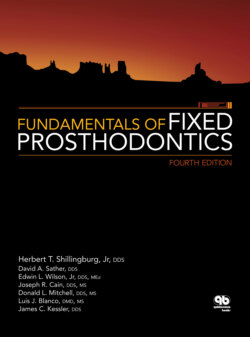Читать книгу Fundamentals of Fixed Prosthodontics - James C. Kessler - Страница 34
На сайте Литреса книга снята с продажи.
Normal versus pathologic occlusion
ОглавлениеIn only slightly more than 10% of the population is there complete harmony between the teeth and the TMJs.31 This finding is based on a concept of centric relation in which the mandible is in the most retruded position. With the present concept of the condyles being in the most superoanterior position with the disc interposed, the results could be different. Nonetheless, in a majority of the population, the position of maximal intercuspation causes the mandible to be deflected away from its optimum position.
In the absence of symptoms, this can be considered physiologic, or normal. Therefore, in the normal occlusion there will be a reflex function of the neuromuscular system, producing mandibular movement that avoids premature contacts. This guides the mandible into a position of maximal intercuspation with the condyle in a less-than-optimal position. The result will be either some hypertonicity of nearby muscles or trauma to the TMJ, but it is usually well within most people’s physiologic capacity to adapt and will not cause discomfort.
However, the patient’s ability to adapt may be influenced by the effects of psychologic stress and emotional tension on the central nervous system.32 An increase in the patient’s stress level will frequently increase parafunctional jaw activity such as clenching or bruxing, and a normal occlusion can become a pathologic one33–37 (Fig 2-15). Simple muscle hypertonicity may give way to muscle fatigue and pain, with chronic headaches and localized muscle tenderness, or TMJ dysfunction may occur. Pathologic occlusion can also manifest itself in the physical signs of trauma and destruction. Heavy facets of wear on occlusal surfaces, fractured cusps, and tooth mobility often are the result of occlusal disharmony. There is no evidence that occlusal trauma will produce a primary periodontal lesion. However, when occlusal trauma is present, there will be more severe periodontal breakdown in response to local factors than there would be if only the local factors were present.38
Habit patterns may develop in response to occlusal disharmony and emotional stress. Bruxism and clenching, the cyclic rubbing together of opposing occlusal surfaces, will produce even greater tooth destruction and muscle dysfunction.
When the acute discomfort of a patient with a pathologic occlusion has been relieved, changes that will prevent the recurrence of symptoms must be effected in the occlusal scheme. Care must also be taken when providing occlusal restorations for a patient without symptoms. The dentist must not produce an iatrogenic pathologic occlusion.
In the placement of restorations, the dentist must strive to produce an occlusion that is as nearly optimum as his or her skills and the patient’s oral condition will permit. The optimum occlusion is one that requires minimal adaptation by the patient. The criteria for such an occlusion have been described by Okeson39:
In closure, the condyles are in the most superoanterior position against the discs on the posterior slopes of the eminences of the glenoid fossae. The posterior teeth are in solid and even contact, and the anterior teeth are in slightly lighter contact.
Occlusal forces are along the long axes of the teeth.
In lateral excursions of the mandible, working-side contacts (preferably on the canines) disocclude or separate the nonworking teeth instantly.
In protrusive excursions, anterior tooth contacts will disocclude the posterior teeth.
In an upright posture, posterior teeth contact more heavily than do anterior teeth.
